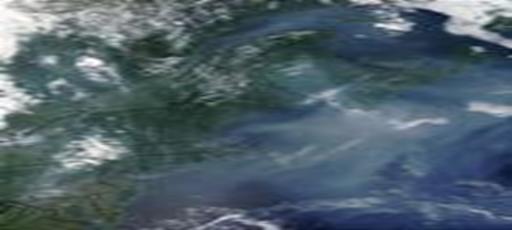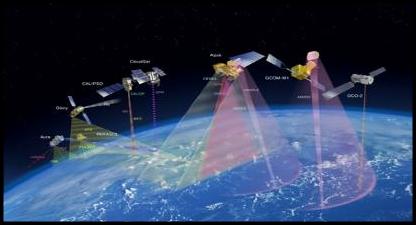|
Remote Sensing Applications of MODIS in Studying Aerosols and Clouds from the TERRA & AQUA Satellites |
|
SITE MISSION This web site focuses on an introductory review of remotely sensed imagery of aerosols and clouds using (MODIS) Moderate Resolution Imaging Spectroradiometer (NASA,2010). Scientists use the data captured by MODIS to analyze the ecosphere and the biogoechemical processes between the land, water , and the atmosphere. While MODIS applications include these various studies this site focuses on the imagery of the aerosols and clouds captured by MODIS(NASA,2010). Links to aerosol data (NOAA,2009). http://www.star.nesdis.noaa.gov/smcd/emb/aerosols/index.php
MODIS: The MODIS instrument is operating on both the Terra and Aqua spacecraft. MODIS has a viewing swath width of 2,330 km and views the entire surface of the Earth every one to two days. Its detectors measure 36 spectral bands between 0.405 and 14.385 µm, and it acquires data at three spatial resolutions -- 250m, 500m, and 1,000m( as cited in NASA,2010). http://modis.gsfc.nasa.gov/about/design.php BACKGROUND NASA began the (EOS) Earth Observing System in 1999 with the TERRA satellite (Nasa,2010). As of 2002 NASA launched the AQUA satellite both of which have orbital parameters that are “near-polar and sun-synchronous” (http://eospso.gsfc.nasa.gov/eos_homepage/mission_profiles/docs/Terra.pdf) Japan the United States and Canada collectively operate the TERRA satellite. The AQUA satellite project is managed by Brazil, Japan, and the United States(http://aqua.nasa.gov/doc/pubs/Aqua_FactSheet.pdf).
TECHNICAL DATA The Spectroradiometric Calibration Assembly (SRCA) of MODIS can detect spatial, radiometric, and spectral patterns(NASA,2010). The sensors have the capacity to detect visible, near infrared and shortwave infrared radiation. MODIS can provide imagery that is important in the study of the general circulation of earths atmosphere including clouds, aerosols from volcanic eruptions and a variety of anthropogenic sources of aerosols.
Link to comprehensive MODIS components list: http://modis.gsfc.nasa.gov/about/components.php
BENEFITS of MODIS APPLICATIONS In terms of climate changes, clouds have a significant influence on the Earth’s temperature and albedo. Clouds absorb, reflect, scatter and trap radiation. As Mackenzie (2003)noted, "High thin clouds are the best warmers” (Mackenzie,2003). Figure 1 AQUA October 10,2010 Cirrus Reflectance Collection 5
http://ladsweb.nascom.nasa.gov/browse_images/l2_browser.html Figure 1& 2
According to NASA(2010) as shown in figure 2, MODIS on the TERRA satellite observed atmospheric aerosols for October 10,2010.These and other imagery using MODIS can detect types of aerosols in addition to radiometric and spectral imagery (NASA, 2010). The atmospheric aerosols from volcanic eruptions influence climate by blocking insolation (Mackenzie,2003). As Figure 3 shows a MODIS image from the AQUA satellite as Schmaltz noted (2006) the Bezymianny volcano erupted and sulfate aerosols were observed drifting near western Alaska (as cited in NASA,2008). http://visibleearth.nasa.gov/view_rec.php?id=20859 Figure 3.
http://visibleearth.nasa.gov/view_rec.php?id=3681 Figure 4
Particulate aerosols can have a cooling effect on earths temperature. Aerosols influence the climate and can lower primary productivity in terms of photosynthetic processes. Anthropogenic aerosols not only affect primary productivity but may cause respiratory illnesses. As shown in figure 4 Jacques Descloitres (2002) found, anthropogenic aerosols blocking out the suns energy and lowering primary productivity in the marine ecosystem off the New England coast ( as cited in NASA, 2002).
|

|
As indicated in Figure 1, the MODIS applications captured the high altitude cirrus clouds reflectance an important factor in forecasting short and long term climate changes by observing what proportion of reradiated energy is being trapped by those cirrus clouds. Other forms of aerosols or particulate matter in the atmosphere can result from humans burning fossil fuels. Wildfires and volcanoes can produce aerosols that can influence earths climate.
|






